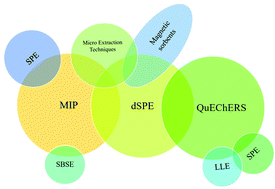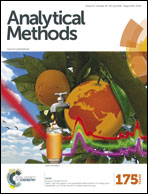Recent advancements in analytical methods for the determination of steroidal estrogen residues in environmental and food matrices†
Abstract
Residual steroidal estrogens in environmental and food samples have become a cause for concern as they can affect organisms at low ppt concentrations. Analytical method development plays a key role in trace estrogen analysis due to the combination of low concentrations and complicated sample matrices. Reliable quantification of these trace level steroidal estrogens has become a major concern during the past decade. This mini review focuses on advancements in analytical methods developed for estrogen detection and quantification in environmental and food samples from 2014–2016. A comprehensive overview of the novelties and the advantages of the recently developed sample pre-concentration, clean-up, and detection methods is discussed. During the past three years, a wide variety of sample extraction methods including the utilization of innovative imprinted magnetic sorbents, QuEChERS (quick, easy, cheap, effective, rugged and safe) method and various microextraction methods such as dispersive liquid–liquid microextraction (DLLME), thin film microextraction (TFME), solid phase microextraction (SPME), and vortex assisted hollow fiber liquid-phase microextraction (VA-HF-LPME) have been published. Further, novel detection methods including electrochemical methods and bio-assays that have been developed for estrogen analysis have also been reported in the recent literature. Further, conventional Solid Phase Extraction (SPE) based methods that have been improved to minimize time, complexity, and cost have been described. These new approaches have resulted in recent significant progress in the analytical chemistry of endocrine disrupting compounds (EDCs) in environmental samples.


 Please wait while we load your content...
Please wait while we load your content...